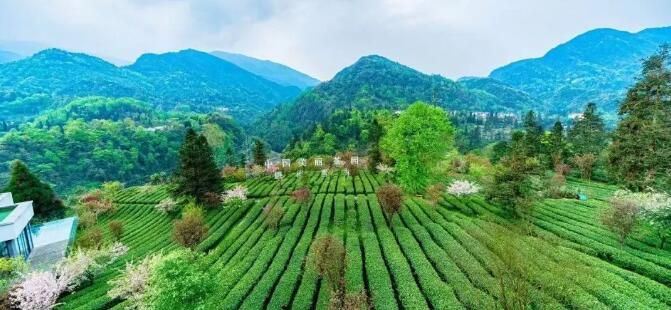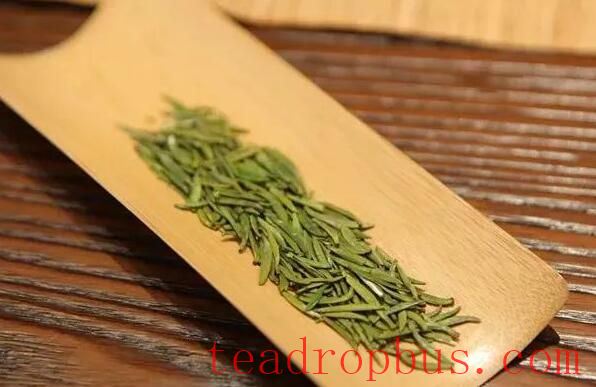In early autumn, the Tea gardens in Leshan are still lush and green. Arriving at the Emei Xueya Heishui Organic Tea Base, one can see that the tea gardens undulate with the terrain, with tea among the forest and forest among the tea, rows of tea bushes sprouting fresh buds that are visible through the mist, creating a picturesque scene.
Good mountains and good waters produce fine tea. The 3,000-acre Emei Xueya Heishui Organic Tea Base is located in the mountains and valleys of the Emei Mountain scenic area at an altitude of over 1,000 meters. Surrounded by mountains and shrouded in a sea of trees, the tea produced here every year is of top quality.

Photo provided by the Publicity Department of the Emei Mountain Municipal Committee
The brand effect has a significant catalytic role in the tea industry. In recent years, our city has adopted a dual-drive approach using both regional public brands and corporate brands to expand the cultural influence of Emei Mountain Tea. “Emei Xueya,” as one of the excellent representatives of Emei Mountain Tea, has led the tea farmers in Xueya Village, Huangwan Town, Emei Mountain City, and surrounding areas towards prosperity, promoting the development of Emei Mountain Tea and becoming a famous Chinese Tea enterprise.
Our city is located in the southwestern part of the Sichuan Basin and is one of the most suitable areas for high-quality Green Tea in China. The city has 1.4 million mu (about 933,333 acres) of tea gardens, 2,000 Tea processing enterprises, and 1 million tea farmers. For residents in the main production areas, 70% of their income comes from the tea industry. We have created three “China Famous Trademarks” and 26 “Sichuan Famous Trademarks.” The brand value of Emei Mountain Tea is 4.644 billion yuan. The scale, quality, and benefits of the tea industry continue to improve, steadily advancing toward the goal of building a global core hub for green tea.
Consolidating fundamentals and enhancing capabilities, we have done ample “tea work.” Currently, our city has formed a “one core, two belts, two zones” industrial development pattern: the “National High-altitude Green Tea Industry Core Area” on Emei Mountain; the 500,000-mu high-quality and efficient tea industry belt between Emei and Jiajiang, and the 800,000-mu green ecological tea industry belt between Jianwei, Mumian, and Mabian; the “Jianjiang Fine Sichuan Tea Export Leading Demonstration Zone,” and the “National Jasmine tea Industrial Advantage Area” in Jianwei. Our city was the first in the province to issue “Twelve Measures to Support the Development of Summer and Autumn Tea Industries,” driving the integration of the tea production supply chain, refined processing chain, and brand value chain. This has enabled the comprehensive strength of the Leshan tea industry to rank first in the province. Working with institutions such as the China National Tea Research Institute, Sichuan Agricultural University, and the Sichuan Tea Science Institute, we have established five expert stations and doctoral stations, conducting demonstrations of mechanized tea gardens, ecological prevention and control, digital tea gardens, and other technologies. We have selected ten new tea plant varieties, including “Emei Wenchun” and “Ziyan,” which have been widely promoted across the country and province.

Gathering momentum to strengthen “tea zones.” We insist on large-scale base development, greening improvement, and social services, always considering base construction as the backbone of tea industry development. We have built one national-level tea zone, five provincial-level tea zones, nine municipal-level tea zones, and 42 tea bases covering more than 10,000 mu each. Two key tea-producing counties (Jianwei County and Jiajiang County) have been included in the advantageous and distinctive cluster construction of agriculture and rural affairs. We have cultivated two national leading enterprises and 195 tea companies above designated size. One company has annual sales exceeding 1 billion yuan, and six companies have annual sales over 100 million yuan, with total annual sales reaching 16 billion yuan. We have established three specialized trading markets for Emei premium green tea, Jianwei jasmine tea, and Mabian high-altitude green tea, with annual transactions totaling 15 billion yuan.
Dual drive to enhance the “tea brand.” We persist with a dual-drive approach of “regional brand + corporate brand,” establishing and improving brand operation mechanisms to continuously increase the recognition and influence of the Emei Mountain Tea brand. We have created three “China Famous Trademarks” and 26 “Sichuan Famous Trademarks.” Bamboo Leaf Green has been listed in the Top Ten Global High-end Famous Teas, being the only Chinese brand on the list. Emei Mountain Tea has been selected for the first batch of protected lists under the China-EU Geographical Indications Agreement, ranking among the top ten regional public brands for green tea in the country, and winning two international gold awards for China's charming tea towns and regions of high-quality tea exports. We have developed the “Five Golden Flowers” of premium green tea (Yizhichun, Forest Snow, Bamboo Leaf Green, Emei Xueya, and Natural Organic Tea), the “Four Little Dragons” of jasmine tea (Xiaoxi Tea, Liangtingzi, Chao Huaganlu, and Qingxi Tea), and the “Three Horses” of export green tea (Hongchun Tea, Huayi Tea, and Baiyue Tea). Through hosting various activities, we constantly enhance the brand value of Emei Mountain Tea.
Linking farmers to expand the “tea bank.” We foster new industries, forms, and models, leaving more value-added benefits and job opportunities from the entire industry chain to tea farmers. There are 1 million tea farmers in the city, and 70% of the income for residents in the main production areas comes from the tea industry, including 350,000 mu of tea planted by impoverished households, generating an average annual income of about 5,500 yuan per mu for tea farmers. We focus on ensuring stable increases in spring tea income, effectively addressing spring droughts, with fresh bud prices remaining consistently stable at 180-300 yuan per kilogram. We pay attention to the comprehensive utilization of summer and autumn tea, focusing on developing “machine-picked tea,” “summer and autumn tea,” and “tea snacks,” extending the industry chain, and conducting 2-3 rounds of machine picking of summer and autumn tea, increasing the average income from summer and autumn tea by 1,500-2,000 yuan per mu. Tea companies employ nearly 100,000 workers throughout the year, with tea gardens providing jobs for 420,000 impoverished households. We have built 83 demonstration points for tea tourism, enabling people to increase their income beyond farming, truly becoming a “green ecological bank.”